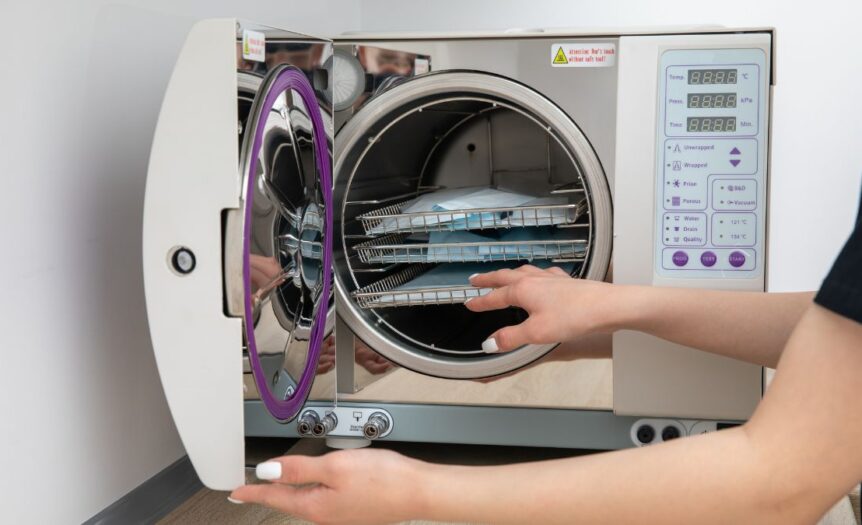Maintaining a sterile environment is non-negotiable in healthcare facilities. Hospitals, being the epicenters of medical treatment, must prioritize sanitation to prevent the spread of infections and ensure patient safety. Critical to achieving this is the selection and use of medical equipment designed to meet the highest standards of cleanliness and hygiene.
Let’s look at the medical equipment all hospitals need to be sanitary and the role it plays in promoting a safe and healthy environment.
Gloves
Gloves are essential medical equipment that all hospitals need to be sanitary. Healthcare workers wear them to protect themselves and patients from harmful microorganisms. Gloves also act as a barrier, preventing skin contact with bodily fluids, chemicals, and other hazardous substances. Infection control experts recommend using disposable gloves made of latex, vinyl, or nitrile, as they are less likely to puncture and easier to dispose of than reusable ones.
Face Masks
Healthcare workers wear face masks during procedures or tasks that could expose them to airborne pathogens. Face masks prevent respiratory droplet transmission from infected individuals to others. Hospitals must provide high-quality face masks that fit securely and consist of hypoallergenic materials.
Gowns
Gowns are essential personal protective equipment (PPE) in hospitals that prevent infections from spreading. Healthcare workers wear them when treating patients with highly infectious diseases or performing procedures that may expose them to bodily fluids. Gowns are typically made of fluid-resistant material and have long sleeves to provide maximum protection against contamination.
Disinfectants
Disinfectants are crucial for sanitizing hospitals by eliminating harmful microorganisms from surfaces and medical equipment. Medical staff use them to clean and disinfect patient rooms, medical tools, and high-touch surfaces like doorknobs and light switches. Hospital administrators must establish a disinfectant protocol, including dilution ratios and appropriate contact times to kill bacteria and viruses effectively.
Sterilizers
Sterilization means eliminating all microorganisms from medical equipment to prevent infections. Hospital staff use sterilizers to ensure surgical instruments, endoscopes, and other reusable medical equipment are free from harmful microorganisms before reuse. They are found on their surgical instrument tray and sterilize tools quickly, efficiently, and safely.
Maintaining a sanitary environment in hospitals is crucial for preventing the spread of infections and keeping patients safe. The selection and use of medical equipment, such as gloves, face masks, gowns, disinfectants, and sterilizers, are essential for achieving this goal. Hospitals must also have strict protocols for cleaning and disinfection to ensure all equipment gets sanitized before each use. With the right measures, hospital administrators can promote a safe and healthy environment for patients and healthcare workers.





 Deering Estate
Deering Estate
 Massage Envy South Miami
Massage Envy South Miami
 Calla Blow Dry
Calla Blow Dry
 My Derma Clinic
My Derma Clinic
 Sushi Maki
Sushi Maki
 Sports Grill
Sports Grill
 The Healthy Kitchen
The Healthy Kitchen
 Golden Rule Seafood
Golden Rule Seafood
 Malanga Cuban Café
Malanga Cuban Café

 Kathleen Ballard
Kathleen Ballard
 Panter, Panter & Sampedro
Panter, Panter & Sampedro
 Vintage Liquors
Vintage Liquors
 The Dog from Ipanema
The Dog from Ipanema
 Rubinstein Family Chiropractic
Rubinstein Family Chiropractic
 Your Pet’s Best
Your Pet’s Best
 Indigo Republic
Indigo Republic




 ATR Luxury Homes
ATR Luxury Homes


 2112 Design Studio
2112 Design Studio
 Hamilton Fox & Company
Hamilton Fox & Company
 Creative Design Services
Creative Design Services
 Best Pest Professionals
Best Pest Professionals
 HD Tree Services
HD Tree Services
 Trinity Air Conditioning Company
Trinity Air Conditioning Company
 Cisca Construction & Development
Cisca Construction & Development
 Mosquito Joe
Mosquito Joe
 Cutler Bay Solar Solutions
Cutler Bay Solar Solutions


 Miami Royal Ballet & Dance
Miami Royal Ballet & Dance
 Christopher Columbus
Christopher Columbus
 Pineview Preschools
Pineview Preschools
 Westminster
Westminster
 Carrollton
Carrollton
 Lil’ Jungle
Lil’ Jungle
 Frost Science Museum
Frost Science Museum
 Palmer Trinity School
Palmer Trinity School
 South Florida Music
South Florida Music
 Pinecrest Orthodontics
Pinecrest Orthodontics
 Dr. Bob Pediatric Dentist
Dr. Bob Pediatric Dentist
 d.pediatrics
d.pediatrics
 South Miami Women’s Health
South Miami Women’s Health

 The Spot Barbershop
The Spot Barbershop
 My Derma Clinic
My Derma Clinic




 Miami Dance Project
Miami Dance Project

 Rubinstein Family Chiropractic
Rubinstein Family Chiropractic
 Indigo Republic
Indigo Republic

 Safes Universe
Safes Universe
 Vintage Liquors
Vintage Liquors
 Evenings Delight
Evenings Delight





 Atchana’s Homegrown Thai
Atchana’s Homegrown Thai
 Baptist Health South Florida
Baptist Health South Florida

 Laser Eye Center of Miami
Laser Eye Center of Miami
 Visiting Angels
Visiting Angels
 OpusCare of South Florida
OpusCare of South Florida

 Your Pet’s Best
Your Pet’s Best





 HD Tree Services
HD Tree Services
 Hamilton Fox & Company
Hamilton Fox & Company


 Creative Design Services
Creative Design Services